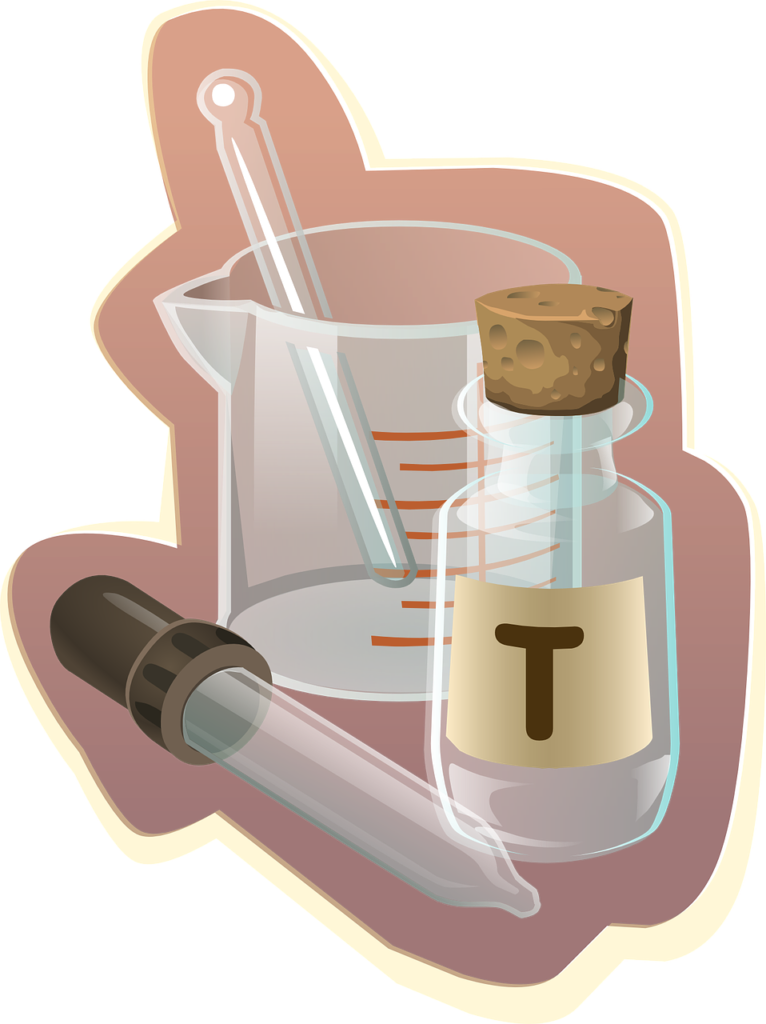1.The language of Chemistry :
(i) Symbol of an element; valency; formulae of radicals and formulae of compounds. Balancing of simple chemical equations.
- Symbol – definition; symbols of the elements used often.
- Valency – definition; hydrogen combination and number of valence electrons of the metals and non-metals; mono, di, tri and tetra valent elements.
- Radicals – definition; formulae and valencies.
- Compounds – name and formulae.
- Chemical equation – definition and examples of chemical equations with one reactant and two or three products, two reactants and one product, two reactants and two products and two reactants and three or four products; balancing of equations. (by hit and trial method).
(ii) Relative Atomic Masses (atomic weights) and Relative Molecular Masses (molecular weights): either – standard H atom or 1/12th of carbon 12 atom.
- Definitions
- Calculation of Relative Molecular Mass and percentage composition of a compound.
| 2. Chemical changes and reactions | (i) Types of chemical changes. Direct combination Decomposition Displacement; Double decomposition (The above to be taught with suitable chemical equations as examples). (ii) Energy changes in a chemical change. Exothermic and endothermic reactions with examples – evolution/absorption of heat, light and electricity. |
| 3. Water | (i) Water as a universal solvent. Solutions as ‘mixtures’ of solids in water; saturated solutions. Qualitative effect of temperature on solubility (e.g. solutions of calcium sulphate, potassium nitrate and sodium chloride in water). (ii) Hydrated and anhydrous substances. (a) Hydrated substances: Water of Crystallisation – meaning and examples. (b) Anhydrous substances: Meaning and examples only (c) Properties: Efflorescence Deliquescence Hygroscopy Removal of hardness (i) By boiling (ii) By addition of washing soda(Definition and examples of each of the above).(iii)Drying and Dehydrating Agents Meaning and examples only. (iv) Soft water and Hard water Meaning, (in terms of action of soap) Advantages and disadvantages of soft water and hard water. Types and causes of hardness |
| 4. Atomic Structure and Chemical Bonding | (i) Structure of an Atom, mass number and atomic number, Isotopes and Octet Rule. Definition of an atom Constituents of an atom – nucleus (protons, neutrons) with associated electrons; mass number, atomic number.Electron distribution in the orbits – 2n2 rule, Octet rule. Reason for chemical activity of an atom. Definition and examples of isotopes (hydrogen, carbon, chlorine).(ii) Electrovalent and covalent bonding, structures of various compounds – orbit structure (a) Electrovalent Bond Definition Atomic orbit structure for the formation of Electrovalent compounds (e.g. NaCl, MgCl2, CaO); (b) Covalent Bond Definition Atomic orbit structure for the formation of Covalent molecules on the basis of duplet and octet of electrons (examples: hydrogen, chlorine, oxygen, nitrogen, hydrogen chloride, water, ammonia, carbon tetrachloride, methane.) |
| 5. The Periodic Table | Dobereiner’s Triads, Newland’s law of Octaves, Mendeleev’s contributions; Modern Periodic Law, the Modern Periodic Table. (Groups and periods) General idea of Dobereiner’s triads, Newland’s law of Octaves, Mendeleev’s periodic law. Discovery of Atomic Number and its use as a basis for Modern Periodic law. Modern Periodic Table (Groups 1 to 18 and periods 1 to 7). Special reference to Alkali metals (Group 1), Alkaline Earth metals (Group 2) Halogens (Group 17) and Zero Group (Group 18). |
| 6. Study of the First Element -Hydrogen | Position of the non-metal (Hydrogen) in the periodic table and general group characteristics with reference to valency electrons, burning, ion formation applied to the above-mentioned element.(i) Hydrogen from: water, dilute acids and alkalis. (a) Hydrogen from water: The action of cold water on sodium potassium and calcium. The action of hot water on magnesium. The action of steam on aluminium, zinc, and iron; (reversibility of reaction between iron and steam). The action of steam on non-metal (carbon). Application of activity series for the above-mentioned reactions. (b) Displacement of hydrogen from dilute acids. The action of dilute sulphuric acid or hydrochloric acid on metals: Mg, Al, Zn and Fe. (To understand reasons for not using other metals and dilute nitric acid.) (c) Displacement of hydrogen from alkalis. The action of Alkalis ((NaOH, KOH) on Al, Zn and Pb – unique nature of these elements. (ii) The preparation and collection of hydrogen by a standard laboratory method other than electrolysis. In the laboratory preparation, the reason for using zinc, the impurities in the gas, their removal and the precautions in the collection of the gas must be mentioned. (iii) Industrial manufacture of hydrogen by Bosch process. Main reactions and conditions.Separation of CO2 and CO from hydrogen. (iv) Oxidation and reduction reactions. Differences in terms of addition and removal of oxygen/hydrogen. |
| 7. Study of Gas Laws | (i) The behaviour of gases under changes of temperature and pressure; explanation in terms of molecular motion (particles, atoms, molecules); Boyle’s Law and Charles’ Law; absolute zero; gas equation; simple relevant calculations. The behaviour of gases under changes of temperature and pressure; explanation in terms of molecular motion (particles, atoms, molecules). Boyle’s Law: statement, mathematical form, simple calculations. Charles’ Law: statement, mathematical form, simple calculations. Absolute zero Kelvin scale of temperature. Gas equation P1 V1 / T1 = P2 V2 / T2; simple relevant calculations based on gas equation. (ii) Relationship between Kelvin scale and Celsius Scale of temperature; Standard temperature and pressure. Conversion of temperature from Celsius Scale to Kelvin scale and vice versa. Standard temperature and pressure. (Simple calculations). |
| 8. Atmospheric pollution | (a) Acid rain – composition, cause and its impact. Sulphur in fossil fuels giving oxides of sulphur when burnt. High temperatures in furnaces and internal combustion engines produce oxides of nitrogen. (Equations to be included). Acid rain affects soil chemistry and water bodies.(b) Global warming: Greenhouse gases – their sources and ways of reducing their presence in the atmosphere. (Water vapour, carbon dioxide, methane and oxides of nitrogen) (c) Ozone depletion Formation of ozone – relevant equations Function in the atmosphere. Destruction of the ozone layer – chemicals responsible for this to be named but reactions not required. |

